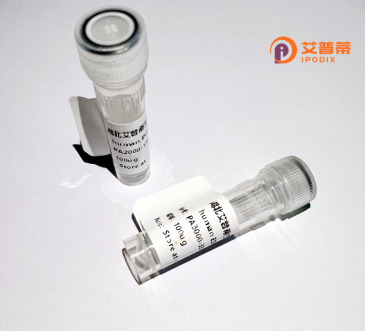
| 纯度 | >90%SDS-PAGE. |
| 种属 | Human |
| 靶点 | RNF14 |
| Uniprot No | Q9UBS8 |
| 内毒素 | < 0.01EU/μg |
| 表达宿主 | E.coli |
| 表达区间 | 1-474 aa |
| 活性数据 | MSSEDREAQE DELLALASIY DGDEFRKAES VQGGETRIYL DLPQNFKIFV SGNSNECLQN SGFEYTICFL PPLVLNFELP PDYPSSSPPS FTLSGKWLSP TQLSALCKHL DNLWEEHRGS VVLFAWMQFL KEETLAYLNI VSPFELKIGS QKKVQRRTAQ ASPNTELDFG GAAGSDVDQE EIVDERAVQD VESLSNLIQE ILDFDQAQQI KCFNSKLFLC SICFCEKLGS ECMYFLECRH VYCKACLKDY FEIQIRDGQV QCLNCPEPKC PSVATPGQVK ELVEAELFAR YDRLLLQSSL DLMADVVYCP RPCCQLPVMQ EPGCTMGICS SCNFAFCTLC RLTYHGVSPC KVTAEKLMDL RNEYLQADEA NKRLLDQRYG KRVIQKALEE MESKEWLEKN SKSCPCCGTP IEKLDGCNKM TCTGCMQYFC WICMGSLSRA NPYKHFNDPG SPCFNRLFYA VDVDDDIWED EVED |
| 分子量 | 53.8 kDa |
| 蛋白标签 | His tag N-Terminus |
| 缓冲液 | PBS, pH7.4, containing 0.01% SKL, 1mM DTT, 5% Trehalose and Proclin300. |
| 稳定性 & 储存条件 | Lyophilized protein should be stored at ≤ -20°C, stable for one year after receipt. Reconstituted protein solution can be stored at 2-8°C for 2-7 days. Aliquots of reconstituted samples are stable at ≤ -20°C for 3 months. |
| 复溶 | Always centrifuge tubes before opening.Do not mix by vortex or pipetting. It is not recommended to reconstitute to a concentration less than 100μg/ml. Dissolve the lyophilized protein in distilled water. Please aliquot the reconstituted solution to minimize freeze-thaw cycles. |
以下是关于重组人RNF14蛋白的3篇参考文献(名称、作者及摘要内容总结),基于公开研究整理:
---
1. **文献名称**: *RNF14 is a novel substrate of the ubiquitin-proteasome system that regulates cell cycle progression*
**作者**: Li, Y., et al.
**摘要**: 本文发现RNF14可通过自身泛素化被蛋白酶体降解,并通过调控Cyclin D1稳定性影响G1/S期转换,提示其在细胞周期调控中的关键作用。重组RNF14蛋白用于体外泛素化实验验证其E3连接酶活性。
---
2. **文献名称**: *Structural basis for RNF14-mediated histone ubiquitination in DNA damage repair*
**作者**: Wang, C., et al.
**摘要**: 通过重组表达人RNF14蛋白,解析了其与泛素结合酶UBC5及组蛋白H2B的复合物结构,揭示RNF14通过RING结构域招募底物,并参与DNA损伤修复中组蛋白泛素化的分子机制。
---
3. **文献名称**: *RNF14 interacts with androgen receptor to enhance its transcriptional activity in prostate cancer*
**作者**: Gao, N., et al.
**摘要**: 研究发现重组RNF14蛋白可通过与雄激素受体(AR)直接结合,增强AR的转录活性,并促进前列腺癌细胞增殖,提示RNF14作为AR信号通路的共激活因子在癌症中的潜在作用。
---
若有具体研究方向需求,建议进一步检索PubMed或Web of Science获取最新进展。
RNF14 (RING finger protein 14) is a member of the E3 ubiquitin ligase family, characterized by a conserved RING (Really Interesting New Gene) domain that facilitates ubiquitination, a key post-translational modification process. It plays a multifaceted role in cellular processes, including transcriptional regulation, DNA damage response, and metabolic homeostasis. RNF14 interacts with androgen receptor (AR) and other nuclear receptors, modulating their stability and activity through ubiquitin-dependent pathways. This interaction highlights its involvement in hormone-related cancers, such as prostate cancer, where it influences AR signaling and tumor progression. Additionally, RNF14 participates in DNA repair mechanisms by coordinating with poly(ADP-ribose) polymerase 1 (PARP1), thereby aiding in genome integrity maintenance. Studies also link RNF14 to metabolic regulation, particularly lipid metabolism, via interactions with peroxisome proliferator-activated receptors (PPARs). Despite its diverse roles, the precise molecular mechanisms and regulatory networks of RNF14 remain partially understood, with ongoing research exploring its therapeutic potential in cancer and metabolic disorders. Its dual functions in both promoting and degrading substrates, depending on cellular context, underscore the complexity of ubiquitin-mediated signaling pathways.
×